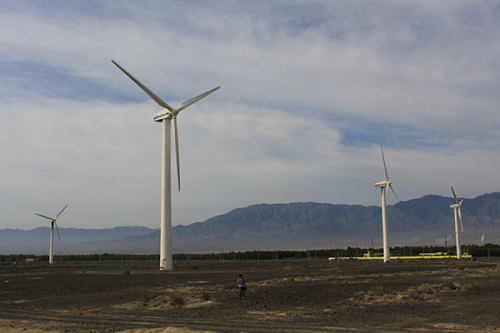
Wind power generation has seen rapid growth in recent years in the Xinjiang Uygur autonomous region and its wind turbines have been sold to 14 countries. (Photo/China Daily)
Struggling firms see doors open to Central Asia, Russian buyers
China's national initiative to revive the ancient intercontinental Silk Road trade routes is being welcomed by equipment manufacturers in the Xinjiang Uygur autonomous region, many of which are keen to expand their reach into markets in Central Asia, and Russia.
Formally known as the Silk Road Economic Belt and the 21st Century Maritime Silk Road, and now being referred to simply as the Belt and Road Initiative, the massive development plan along the routes is aimed at promoting the interconnection of infrastructure, and economic and cultural exchanges with neighboring countries.
"It feels like a new road is being directed toward us," said Yang Xuejun, Xinjiang branch manager of Goldwind Science and Technology Co Ltd, China's largest wind turbine maker.
"The initiative will definitely help our exports to those countries," Yang said Goldwind had previously taken a cautious approach toward investment in Central Asia, mainly because many local companies had faced problems in finding the finance needed to expand their operations there.
Established in 1998 in Urumqi, Goldwind had sold 15,000 wind turbines to 14 countries by the end of last year, and had total assets worth 34.4 billion yuan ($5.61 billion).
The company has relied on Europe, Australia and South America for any export growth, with the Central Asian market accounting for just a tiny percentage of overseas sales, despite its geographic proximity.
"If the initiative, especially the planned Silk Road Fund, manages to reach out to these companies and provide them with financial support, we will definitely increase our investments there," he said.
The Belt and Road Initiative could also prove crucial for industrial companies fighting plunging market demand at home, allowing them to redirect excess production capacity overseas, such as Shanqi Xinjiang Automobile Co Ltd, an Urumqi producer of heavy-duty trucks.
Ke Xianzhi, its deputy general manager, said the automaker's sales this year have been hit hard by a slump in domestic demand, and a depreciation of the Russian rouble.
"The initiative has offered a silver lining to our business, as the overcapacity of production within this region seems to be an insurmountable challenge right now," he said.
Shanqi Xinjiang Automoble's sales inside the autonomous region have fallen by more than 50 percent since the start of this year, due to the sluggish demand and a plunge in new property construction, he said.
The company has annual production capacity of 15,000 trucks, but has only been operating a single production line inside its factory, which delivered just 3,000 units in 2014.
"Even for the country's top five truck makers, a yearly production volume of 100,000 trucks is out of the question at present," said Ke.
"It's a challenge being faced by all heavy-machinery makers, if they solely rely on the domestic market."
Ke said his company redirected its expansion strategy overseas, as soon as the country proposed the Belt and Road Initiative, and is planning to build an assembly plant in Kazakhstan to increase export sales.
The new facility will enable the automaker to reduce the cost of custom duties, he said, and improve its competitive edge in the local market.
"Compared with other leading foreign products, our advantage still lies in price. We need to protect that as we expand overseas," he said.
The Kazakhstan plans are likely to be repeated elsewhere along the Silk Road Economic Belt, he said, to further increase volumes.
"We expect the heavy-duty truck market to pick up in the later part of next year as the Belt and Road Initiative, and its related projects, become a reality."
















































